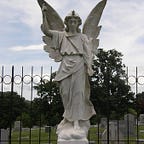THE MANY BALLADS OF NELL CROPSEY
The mysterious death of Nell Cropsey in Elizabeth City in 1901 has sparked a number of folk ballads that were long popular in the eastern part of the state. One of the earliest ballads was collected in 1912 by West Virginia folklorist Louis W. Chappell, a native of Belvidere who would have been a boy at the time of the case. Chappell believed that it, and another ballad collected by a Mrs. L. A. Spencer of Elizabeth City in 1902, were composed between Nell’s disappearance on the night of November 20–21, 1901, and the discovery of her body in the Pasquotank River on December 27 of the same year. In fact, both ballads were probably written after the discovery of Nell’s body, or at least were revised to reflect the discovery of the body. The first ballad, referred to as “Nell Cropsey, I” by Chappell in his 1939 book Folk-Songs of Roanoke and the Albemarle, certainly ended on an ambiguous note:
Days went by, they searched for Nellie,
But their search was all in vain,
And perhaps they thought her living
And would soon return again.
However, the first two stanzas make it plain that the author was aware that Nell Cropsey was murdered. The first stanza runs
On the twentieth of November,
A day you all remember,
’Twas then a handsome girl was murdered,
Of her story I will tell.
The second stanza consists of a warning to girls “on how you treat a man”:
For they will pretend to love you
And will kill you if they can.
The second ballad, which Chappell referred to as “Nell Cropsey, II” was addressed to the Pasquotank itself, and clearly was written with the knowledge that Nell’s body was found in the river:
Oh, swift flowing river,
A secret you hold
Way down in the depths
Of the water so cold.
Another Cropsey ballad, collected by Chappell in 1912, was labelled by him as “Nell Cropsey, III”. It is ostensibly from the viewpoint of Jim Wilcox, and is a confessional ballad, purporting to be Wilcox’s confession of the murder, and his warning to other young men to avoid the influences of the devil, which drove Wilcox to commit the crime. Chappell pointed out that the ballad actually is a variation of an old British ballad, known as (among many other titles, with many localized variations as to alleged setting) “The Cruel Miller” and “The Wexford Girl.” To note some of the comparisons:
“Nell Cropsey, III”
My dear old parents brought me here/Provided for me well,/And in the city of Dixie Belle/They placed me in the mill.
I went over to her sister’s house/’Twas eight o’clock that night,/And little did the poor girl think/Against her I had a spite./I asked her to take a little walk,/A little ways with me,/So we might have a little talk/About our wedding day.
compared to “The Cruel Miller”
My parents educated,/good learning gave to me./They bound me to a miller,/which I did agree
I went unto her sister’s house/at eight o’clock at night,/little did this fair maid think/I owed her much in spite./I asked her if she’d take a walk,/all in the meadows gay,/And there to sit and talk a while/about our wedding day.
Comparisons between another Nell Cropsey ballad, of which he collected three variations under the title “Nell Cropsey, IV, A,” “Nell Cropsey, IV, B,” and “Nell Cropsey, IV, C,” and an earlier ballad called “Fair Florella.” These varied parallels between two different Nell Cropsey ballads and older European ballads suggest something of the transmission of ballad materials over time, where lyrics are adapted from their original settings and attached to many different local events widely separated by place and time. It is worth noting in this context that most of the Nell Cropsey ballads fail to mention her by name.
A version of the “Nell Cropsey, III” ballad (with somewhat different lyrics from version published by Chappell) was performed by Outer Banks folk artist Isabelle Etheridge for the “various artists” album Between the Sound and the Sea: Music of the North Carolina Outer Banks (1977), under the title “Nellie Cropsey.” The album consisted of field recordings made in the Outer Banks area by ethnomusicologist Karen G. Helms in the 1970s.
A more recent song about Nell Cropsey was created and performed by the award-winning group the Red Clay Ramblers. “The Ballad of Beautiful Nell Cropsey” was released on the band’s 2009 cd Old North State.
The song grew from a book written by author and musician Bland Simpson, a member of the group, entitled The Mystery of Beautiful Nell Cropsey: A Nonfiction Novel (1993). Simpson and his bandmates developed the book into a musical suite, “The Mystery of Beautiful Nell Cropsey,” for performance by the Carolina Ballet as part of a larger musical piece called Carolina Jamboree; the song was originally part of the suite and was recorded twice by the group, first for a cd of the Carolina Jamboree music, and then separately for Old North State.
~by Mike Coffey
